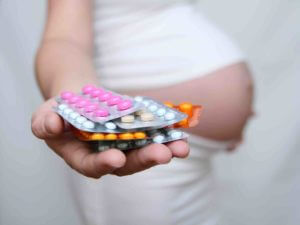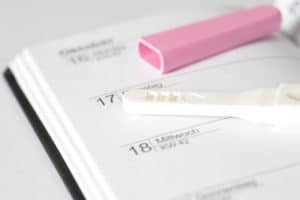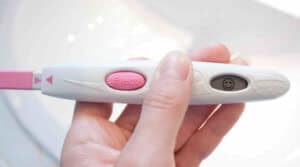Ovulation symptoms vary from woman to woman. If you want to get pregnant, you can use this article to get to know your body better. There are three sure signs of fertile days that occur in all women.
These include the change in basal temperature, the change in cervical mucus, and the change in the cervix. Watching your body so closely may take some effort. But you will build a better relationship with your body.
This will help you to get pregnant in a relaxed way. Other symptoms do not occur in all women and not in every cycle. These symptoms include nausea, mittelschmerz, chest pain, light bleeding, increased resting heart rate, and swelling of the lymph nodes in the groin.
With a little practice, you will be able to interpret your body’s signals clearly. You will develop a sense of where you are in your cycle and when you are ovulating.
We wish you much joy and success in exploring this exciting phase in your life.
Table of contents
Ovulation: What You Should Know
Ovulation has symptoms that you can use to determine when you can get pregnant. Not every woman has the same symptoms and some women do not notice the ovulation signs.
With a little patience and observation, you can accurately determine fertile days.
If you want to get pregnant and have an irregular cycle, have recently stopped taking the pill, or have hormonal peculiarities, you can better check your cycle at the gynecologist with an ultrasound.
In addition to the ovulation signs listed below, you can buy ovulation tests at the pharmacy. They determine the luteinizing hormone (LH) in the body.
This hormone plays a role in triggering ovulation. Three to two days before ovulation, the concentration of luteinizing hormone in the body increases.
However, the ovulation test, like cycle apps, does not have one hundred percent certainty. How you can calculate ovulation, you can read here. It’s best to listen to your body. It will tell you what’s going on inside.
A look Inside Your Body – Ovulation
Ovulation is the time when the egg is released from the ovary into the fallopian tube. The medical term is ovulation. Every month, 15 to 20 eggs mature in the ovaries. This usually takes between 12 and 16 days.
The largest egg leaves the ovary and is ready for fertilization for 12 to 24 hours. The monthly cycle begins with the first day of menstruation. In the middle of the cycle is ovulation. These are the fertile days.
Since sperm have a maximum life span of five days in a woman’s body, the best time for fertilization is before ovulation. The highest probability that you will become pregnant is two days before ovulation.
If a sperm cell meets the egg, it is fertilized and nests in the lining of the uterus. If the egg is not fertilized, menstruation starts after 12 to 16 days and the cycle begins again.
Every woman is different and even a woman’s cycle can fluctuate because it depends on many factors. Instead of relying on timing alone, you should include other ovulation signs in your consideration.
This way you will know the timing of your monthly ovulation and when you are fertile.
Symptoms Of Ovulation
- Change in basal temperature.
- Spinnable cervical mucus.
- Changes in the cervix.
- Occurrence of midline pain.
- Occurrence of bleeding.
- Tension in the breast.
- Sensitive nipples.
- Increased desire for sex.
- Increased resting heart rate.
- Swollen inguinal lymph nodes.
If you are looking for signs of fertile days, you should observe at least two of the above features in you. Changes in basal temperature, cervical mucus, and cervix are sure ovulation symptoms.
The other symptoms may occur in some women. Nausea is experienced by some women right after ovulation, others in the phase before menstruation (part of premenstrual syndrome), and nausea is a pregnancy sign.
Measuring Basal Body Temperature And Fertile Days: What’s Behind It?
Your body changes hormonally during your cycle. A good sign of ovulation is the increase in your basal body temperature. This is the temperature before you get up.
You measure it after waking up in bed. In the first half of the cycle, the temperature is lower.
On the day of ovulation, it usually drops and then increases by 0.2 to 0.5 degrees Celsius.
An accurate measurement will show you your temperature curve, ovulation, and when you are fertile. Many women need to gain experience to recognize the ovulation signs. Measuring basal body temperature sounds easy.
However, you need two to three months to master the method.
This Affects The Basal Body Temperature:
- Too little sleep.
- Illness.
- Different thermometers.
- Medication.
- Alcohol.
- Different measuring times.
The Cervical Mucus And Sperm Cells
Many women don’t realize how much their bodies change during a cycle. The cervical mucus, sometimes called discharge, helps the sperm cells to reach the uterus quickly and better.
If you want to observe cervical mucus, you may have to get over yourself a little. But you will get to know your body better and this will positively influence your whole relationship with yourself.
At the beginning of the cycle, the pH of the vaginal environment is in the acidic range. Sperm cells do not survive long in this environment. The vagina feels dry. There is hardly any mucus, although this varies from woman to woman.
Some have more cervical mucus and others have less. On infertile days, the mucus is white to yellowish, creamy, and does not pull strings. A sign of ovulation and when it starts is the increasing amount of cervical mucus.
You can recognize fertile days when your vagina feels wet without being aroused. The cervical mucus is then transparent and viscous.
If you pull it apart with your thumb and index finger, it forms threads. It is spinnable. Many women compare its consistency to raw egg whites. Cervical mucus helps sperm reach the egg more quickly.
This Is How You Can Test Cervical Mucus:
- Place one leg elevated (on the toilet, the tub, or a chair).
- Insert a clean finger into the vagina.
- Feel for a small, round thickening (the cervix) on the side facing the abdomen.
- Gently pass around the cervix.
- Pull the finger out and assess the cervical mucus.
- In the beginning, you should assess the cervical mucus at least once a day to get enough practice.
This Is The Role Of The Cervix
Your body gives you clear symptoms of fertile days. Your cervix cannot talk to you directly, but you can feel it carefully and it will tell you when ovulation is imminent. At the beginning of the cycle, you can feel the cervix well.
It is hard, spherical, and protrudes into the vagina. As ovulation approaches, the cervix retracts upwards, becomes soft, and looks more like a plate than a ball in the surrounding tissue.
This is a clear sign of ovulation. The cervix opens a little on fertile days to let sperm into the uterus.
Middle Pain – This Is Behind The Ovulation Symptom
Some women can tell exactly when the egg leaves the ovary. They also know which ovary produced the egg. They perceive the so-called mittelschmerz as a pulling, stabbing, or cramping pain in the lower abdomen.
The pain can last from a few seconds to two days. While some women can see very clearly which ovary is affected, others perceive the mittelschmerz more diffusely.
It may radiate to the back and legs, or it may be felt as the pressure in the perineal area. Mittelschmerz occurs in the middle of the cycle, i.e. at the time of ovulation. This is where the name comes from.
Even if you feel this pain, this alone is not suitable as an ovulation sign. Digestive problems can cause similar symptoms. Make sure you use two of the methods mentioned above.
Then you can safely determine fertile days.
The middle pain should not be confused with the pain of implantation. This is a sign of pregnancy. Women feel the fertilized egg implanting in the lining of the uterus.
The change in the uterus and surrounding tissue also causes pulling or stabbing pain.
Bleeding During Ovulation
Ovulation bleeding occurs around the time of ovulation in some women. This bleeding is light, rather than a dark discoloration of the discharge. Spotting may also occur from sexual intercourse during this time.
The reason for the bleeding around ovulation is the thickened cervical mucus built up by estrogen. If there is not enough progesterone, the cervical mucus can cause light bleeding or a dark discharge.
Since you can also confuse ovulation bleeding with real menstruation, you should observe other ovulation symptoms.
This Is Why Your Breasts Change
The symptoms women experience during fertile days are varied. For some, the breasts hurt, tighten, or pull. Bras are suddenly uncomfortable.
Your breasts may be fuller. Also, your nipples may be more sensitive.
Other Ovulation Symptoms
Although you may be quite analytical about child planning, our bodies work without our heads. You may notice fertile days because you simply feel more like having sex.
Sex drive is influenced by many factors. You should not worry if this is not an ovulation symptom for you.
Increased Resting Pulse Rate As A Sign Of Fertile Days
The change in resting pulse rate is a scientifically new observation. Five to two days before ovulation, the resting pulse rate increases by two to four beats per minute. After ovulation, it increases again.
If you become pregnant, the resting pulse rate remains higher, otherwise, it drops again. Again, you should take a measurement as regularly as possible and pay attention to factors that change the pulse (illness, sleep, exercise, caffeine, etc.).
Swollen Lymph Nodes In The Groin
An unknown feature as an ovulation symptom is the swelling of the lymph nodes in the groin. The lymph nodes are located on the side of the pelvic bones. You can feel them when they are swollen as lumps about the size of a pea when lying down.
They swell in 70 percent of women a few days before ovulation on the side of the ovary that produced the egg.
No Ovulation?
Some women do not observe any of the ovulation symptoms mentioned above. This does not mean that ovulation has not occurred. There may be measurement errors or incorrect assessment of symptoms.
Failure to ovulate is possible. This can be caused by factors such as stress and illness. As long as this does not continue for a long period of time, it is not a cause for concern.
If ovulation really does fail to occur, the basal temperature will not show any increase.













1 thought on “Watch Out: You Should Know These Ovulation Symptoms”